
Severely degraded spectacle frames. Photo: Deutsches Museum | Christina Elsässer
Conservation science
Cold storage of museum objects made of cellulose nitrate
Objects made of the plastic cellulose nitrate are a great challenge for museums. They age quickly and pose a threat to the collection through the emission of decomposition products. Can cold storage slow down decay without risking further damage?
Content
Cold storage of museum objects made of cellulose nitrate – mechanical stress versus chemical degradation
Funded by
Deutsche Bundesstiftung Umwelt
- Conservation science
- Natural Sciences
Edited by
Dr. Marisa Pamplona Bartsch
Leitung Abteilung Konservierungswissenschaft
Christina Elsässer
Ehem. wiss. MitarbeiterinKonservierungswissenschaft
Dr. Anna Micheluz
Stellvertretende LeiterinAbteilung Konservierungswissenschaft
Dr. Stefani Kavda
Scholar in ResidenceForschungsinstitut
M.A. Teresa Donner
ehemalige Masterandin und ScholarinScholars in Residence
Veronika Mayr
MasterandinTechnische Universität München
Project description
Objects made of cellulose nitrate (CN) are problematic for museums because they decompose quickly. The lower the temperature, the slower the chemical decomposition processes and thus the decay of the objects. However, cooling down can put the exhibit under physical stress and damage it in turn. The research aims to optimise the storage of objects made of CN by lowering the temperature and to establish suitable guidelines, keeping in mind the aspect of sustainability and feasibility for museums.
Between fascination and conservation problems
It is the responsibility of museums to preserve the cultural heritage for future generations. Museums of science and technology as well as design or art collections possess valuable objects made of CN. However, CN is one of the most unstable types of plastic in a museum context and is therefore difficult to preserve. When CN degrades, highly corrosive and harmful gases can be produced, which further decompose the polymer substance. In addition, surrounding objects as well as packaging materials and shelves that are in direct contact with or in the vicinity of CN are also severely damaged. Once the degradation of CN has begun, the conservation possibilities for museums are limited. They are often forced to deaccess affected objects, i.e. to remove the objects from the collection in order not to endanger other exhibits.
Building on the familiar – cold storage of films and photographs
Most people are familiar with CN material from old film reels and may have heard about their fire hazard, which destroyed many cinema buildings in the 20th century. In order to reduce this risk, CN film reels worth preserving are now stored in a refrigerated environment. This has the practical side effect of slowing down chemical degradation reactions in the material.
Slowing down the ageing process is essential for the preservation of CN objects. Cold storage is a practice that archives for film and photographic materials already use, but it is only rarely applied to 3D objects.
Slowing down the chemical degradation and minimising tension
The collection of the Deutsches Museum contains a large number of CN objects in different colours, shapes and with different material combinations (e.g. CN-metal, CN-wood). Diverging temperature gradients and different coefficients of thermal expansion can lead to stresses and thus to damage during the cooling and heating processes. The possible risks of cold storage for collection material made of CN are to be assessed in this research project.
Making the invisible visible
The slowing down of chemical degradation will be monitored by repeated chemical analyses. The main decomposition mechanisms of CN will be examined. Are there, due to cold storage, further
- chain scissions (gel permeation chromatography),
- hydrolysis of the nitro group (ion chromatography) and
- loss of camphor (gel permeation chromatography)?
Read more about it:
Christina Elsässer, Anna Micheluz, Marisa Pamplona, Peter Montag: Selection of thermal, spectro-scopic, spectrometric and chromatographic methods for assessing the condition of celluloid in museums; eingereicht in: Journal of Applied Polymer Science, Wiley
In addition, the mechanical and physical stresses to which the specimens are subjected by cooling and warming processes play a major role. Stresses and damages that can result from cooling and warming processes are to be made visible by imaging techniques and evaluated by mechanical testing.
- Does an increase of material-immanent stresses occur during cooling (photoelasticity), leading to crack propagations (computed tomography)?
- When is a critical stress level reached that causes a new crack (Thermomechanical analysis)?
The aim of these investigations is to establish initial limit values and to develop suitable storage conditions, which should result in guidelines for museums.
Picture Galery
Subprojects
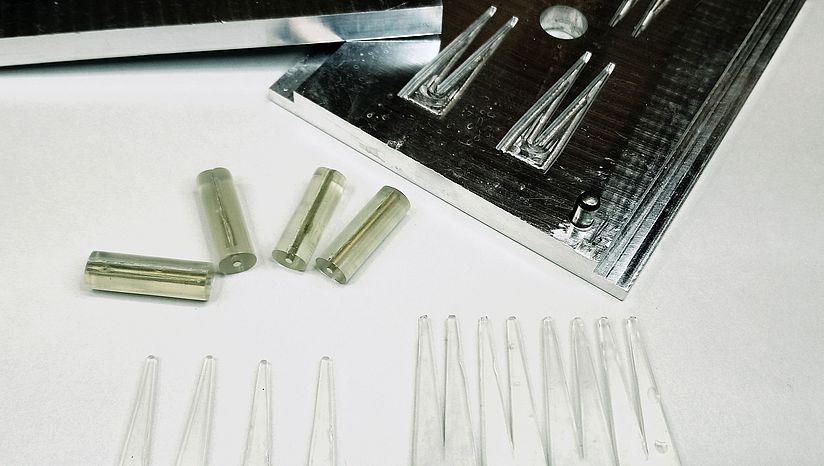
Press mould with freshly produced specimens. Photo: TU München/Deutsches Museum | Veronika Mayr
Production of specimens to investigate material behaviour
Before unique museum items can be stored in a cold place, it must be ruled out that the transfer of the objects to the cold induces any mechanical damage to the objects. Moisture damage due to condensation must also be avoided. For corresponding tests, specimens with properties as similar as possible to those of museum objects under consideration for cold storage are required.
The master’s thesis of Veronika Mayr, a student of restoration, art technology and conservation science at TU Munich, had the aim of designing and producing such specimens in order to make the effects of cold storage testable. The specimens should be representative for collection objects in both material combination and their simplified shape. The results were “double spires”, which represent a section of a hair comb, and a CN cylinder with a metal core, which is modelled on a spectacle temple.
The production of the specimens was made more difficult by the fact that historical manufacturing methods from the first half of the 20th century to the early 1970s are no longer available today. Through newly developedtechniques and methods thin celluloid plates – the only form of celluloid still on the market – could be converted into the above-mentioned geometries. The Deutsches Museum was supported in this process by the Department of Mechanical Engineering at TU Munich, which provided both expertise and technology.
After production, the specimens were artificially aged in a climate chamber through increased temperature and humidity. The properties of the test specimens were investigated before and after ageing, for example with infrared spectroscopy and gel permeation chromatography.
Subsequently, different parameters of cold storage can be tested on identical replicas of these specimens. Thus, harmful effects during the later cold storage of the museum goods can be excluded.

Injection of a sample into the gel permeation chromatography system to determine chain lengths. Photo: Deutsches Museum | Christian Illing
How much do plastic museum objects age? Tracking chain scission with Gel Permeation Chromatography
Gel Permeation Chromatography (GPC), also known as Size Exclusion Chromatography (SEC), is a liquid chromatographic analytical technique used to measure the molecular weight of polymers. One of the causes of polymer ageing and degradation is the shortening of its molecular chains through a process known as chain scission; therefore, the more degraded a material, the lower its molecular weight. In our research, a GPC/SEC method was developed and optimised to study the ageing behaviour and long-term preservation of museum objects made of cellulose nitrate with camphor. The newly developed method uses the smallest possible amount of sample, dissolved in a suitable solution of dimethylacetamide with lithium chloride that induces no further degradation to the sample. In the future, GPC/SEC will be used to monitor the effects of cold storage on museum objects.
Read more:
Kavda S., Micheluz A., Elsässer C., Pamplona M. (2021): Development of a gel permeation chromatography method for analysis of cellulose nitrate in museums. Journal of Separation Science, https://doi.org/10.1002/jssc.202001018.
(https://analyticalsciencejournals.onlinelibrary.wiley.com/doi/full/10.1002/jssc.202001018?af=R)

The pink stain on the indicator paper is proof that nitrous gases are emitted by the celluloid object. Photo: TU München / Deutsches Museum | Teresa Donner
Celluloid in museum collections – possibilities of cold storage and investigation on degradation processes
The master’s thesis of Teresa Donner at TU Munich, for a degree in Restoration, Art Technology and Conservation Science (2018/2019), is closely connected to the DBU project “Cold storage of museum objects made of cellulose nitrate – mechanical stress versus chemical degradation”.
Within this master’s thesis, an international survey was conducted to assess if and how museums preserve celluloid objects in cold storage. Out of 36 participants worldwide, only four institutions have already implemented this preventive measure.
Furthermore, the plastics present in nearly 100 objects from the Deutsches Museum’s collection were identified by means of Fourier Transformed Infrared Spectroscopy. The 60 celluloid objects thus identified are now stored separately from the rest of the collection by the collection’s management department.
Finally, degradation phenomena such as the formation of acidic moisture drops, acidic crystals and the typical cracking inside the material could be observed.
These investigations were the basis for the Scholar in Residence Project 2020.
Publications
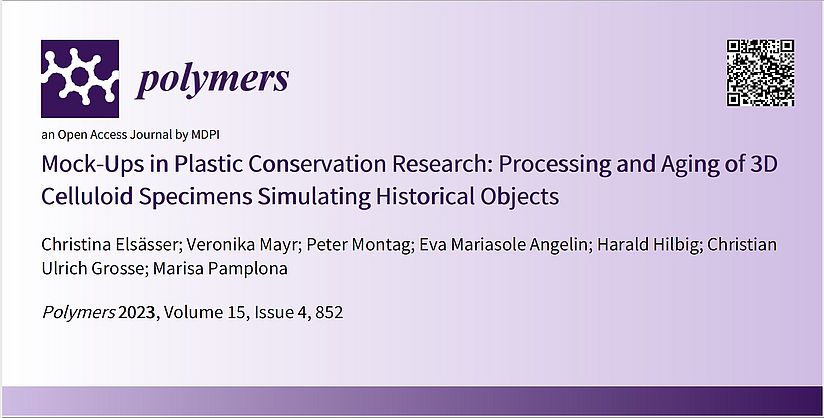
Photo: MDPI
Christina Elsässer, Veronika Mayr, Peter Montag, Eva Mariasole Angelin, Harald Hilbig, Christian Ulrich Grosse and Marisa Pamplona
Mock-Ups in Plastic Conservation Research: Processing and Aging of 3D Celluloid Specimens Simulating Historical Objects
Abstract:
The preparation of mock-ups in heritage science studies represents a valid alternative for investigation purposes, avoiding extensive sampling of cultural heritage objects. This work presents for the first time the successful preparation of three dimensional (3D) mock-ups made of celluloid, considering a combination of historical industrial production strategies and small-scale lab facilities. Prefabricated transparent celluloid sheets were acquired and then shaped through compression molding for creating mock-ups with 3D geometries. These reflected common and representative shapes encountered in the collection of the Deutsches Museum. Visual inspection of the mock-ups allowed determining the best compression molding conditions. Attenuated total reflection Fourier-transform infrared spectroscopy (ATR-FTIR) confirmed the absence of molecular heterogeneity due to the processing method. Artificial aging of the mock-ups was conducted to reach degradation states comparable with naturally aged objects. ATR-FTIR investigation offered first insights into the induced artificial degradation. Ion chromatography (IC) and gel permeation chromatography (GPC) analyses allowed to assess the extent of the artificial aging of the celluloid mock-ups and confirmed the occurrence of loss of camphor, denitration, and main chain polymer scission, the latter being the predominant decay path. The comparison with historical objects highlighted that the mock-ups are representative of moderately aged artifacts. As such, this study paves the way for implementing moderately aged celluloid 3D mock-ups in heritage science research, enabling in-depth testing for the scope of conservation.
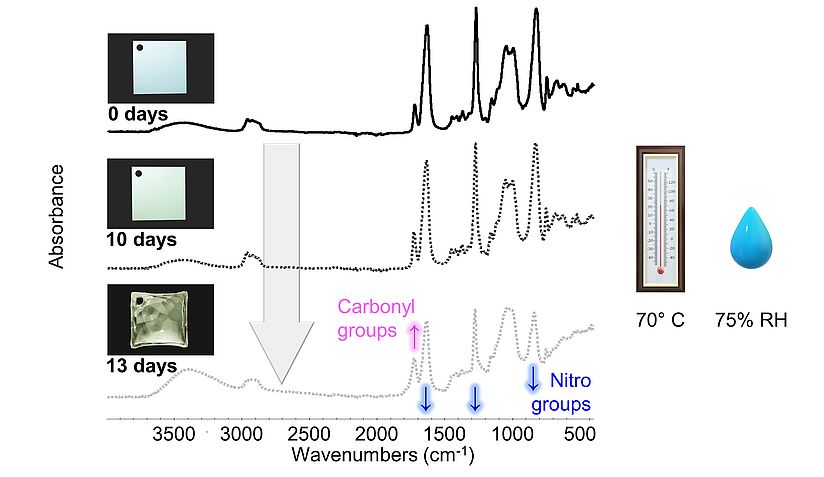
Photo: Deutsches Museum
Marco Valente Chavez Lozano, Christina Elsässer, Eva Mariasole Angelin and Marisa Pamplona
Shedding Light on Degradation Gradients in Celluloid: An ATR-FTIR Study of Artificially and Naturally Aged Specimens
Abstract: Celluloid artifacts are known by conservation professionals to be prone to degradation,threatening their own integrity and that of nearby heritage collections. Celluloid alteration can have a heterogeneous nature, and this research topic is still in its infancy for heritage science. This article investigates degradation gradients, both along depth and width, of artificially aged celluloid sheets, and compares them to three-dimensional (3D) historical objects with the aim of gaining a better insight into the nature and evolution of their decay. ATR-FTIR was used to systematically study different sampling points of the artificially and naturally aged specimens and allowed us to recognize better-preserved surfaces and more deteriorated cores. ATR-FTIR was found suitable for assessing the molecular changes induced by degradation, particularly denitration and formation of carbonyl-containing degradation products in severely aged specimens. Even though the severely artificially aged sheets displayed unusual alteration phenomena, they present a degradation gradient similar to the one observed for the naturally aged 3D objects under study. This research underlines that sampling at different depths and/or widths is relevant for characterizing the heterogeneity of degraded celluloid, and further investigation with chromatographic techniques would greatly benefit the understanding of the complex degradation of celluloid artifacts.
Link:
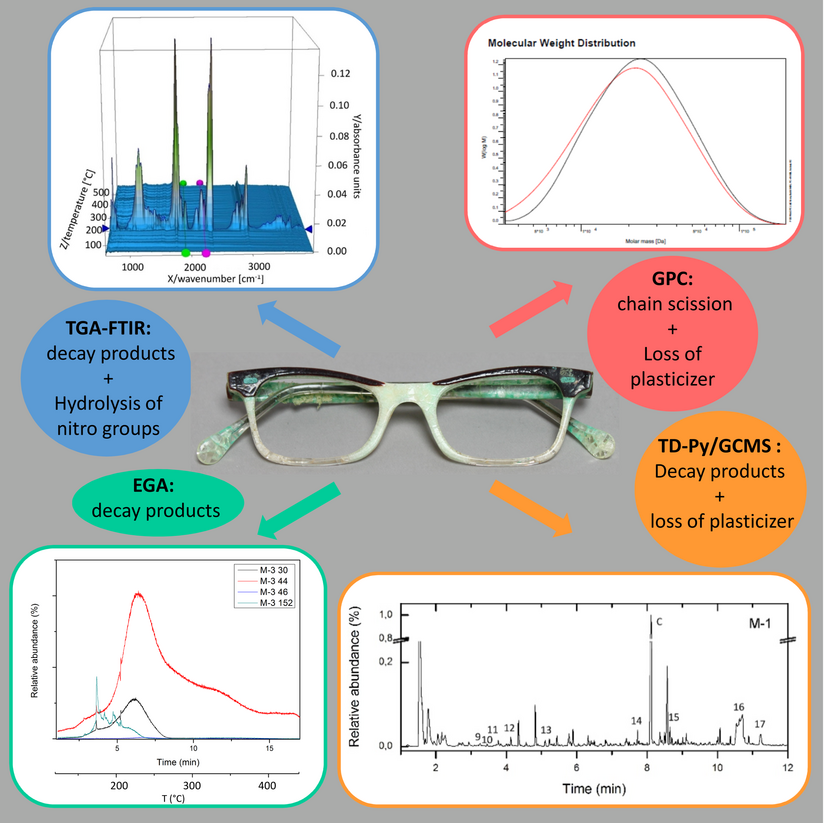
Publication Elsässer, Pamplona, Micheluz, Kavda, Montag. Photo: Deutsches Museum
Christina Elsässer, Anna Micheluz, Marisa Pamplona, Stefani Kavda, Peter Montag
Selection of thermal, spectroscopic, spectrometric and chromatographic methods for characterizing historical celluloid
Abstract
Celluloid in museum collections is very unstable; therefore, heritage professionals carry out research studies dedicated to understanding its decay and prolonging its lifetime. This paper addresses the need to compare and select suitable analytical methods for that purpose. Thermogravimetric analysis coupled with Fourier transform infrared spectroscopy, evolved gas analysis–mass spectrometry, double shot – gas chromatography/mass spectrometry, and gel permeation chromatography (GPC) were employed to characterize the emission of gasses (decay products) and measure the molecular weight and camphor (plasticizer) content from unaged, artificially, and naturally aged celluloid samples. A pioneer GPC set‐up for the quantification of camphor was introduced for the first time in this study. Results demonstrated that GPC was the most suitable method for assessing material changes due to degradation. Both set‐ups, for measuring molecular weight and quantifying camphor, appear promising for assessing the effect of conservation treatments and investigating the heterogeneous degradation of celluloid objects in future studies.
More Information concerning our authors
Christina Elsässer, Anna Micheluz, Marisa Pamplona, Stefani Kavda
Open Access:
http://dx.doi.org/10.1002/app.50477
Stefani Kavda, Anna Micheluz, Christina Elsässer, Marisa Pamplona
Development of a gel permeation chromatography method for analysis of cellulose nitrate in museums
This article describes the development of a suitable Gel Permeation Chromatography method for cellulose nitrate plasticised with camphor (celluloid) found in cultural heritage. Current sample preparation and dissolution methods, apart from focusing on native, nonderivatised cellulose, require long preparation times, and often employ solvents that induce degradation. This study aims to develop a systematic method for sample preparation of cellulose nitrate that uses the least sample amount possible, is nondegrading, and can be applied on differently aged samples. This is investigated through identification of a suitable solvent system and a statistically designed experiment testing the critical variables affecting the analysis, namely sample condition, sample, and salt concentration (lithium chloride) in N,N‐dimethylacetamide. The use of 0.1% sample was inadequate for analysis because it did not fully dissolve in any salt concentration, while the 0.3% negatively impacted the analysis with its high molecular weight distributions. The 0.2% cellulose nitrate in a solution of 0.5% lithium chloride in N,N‐dimethylacetamide offered the most consistent and repeatable molecular weight data. This method miniaturised the sample as much as possible and is suitable for museum objects in various ageing conditions.
Open access:
https://analyticalsciencejournals.onlinelibrary.wiley.com/doi/pdf/10.1002/jssc.202001018
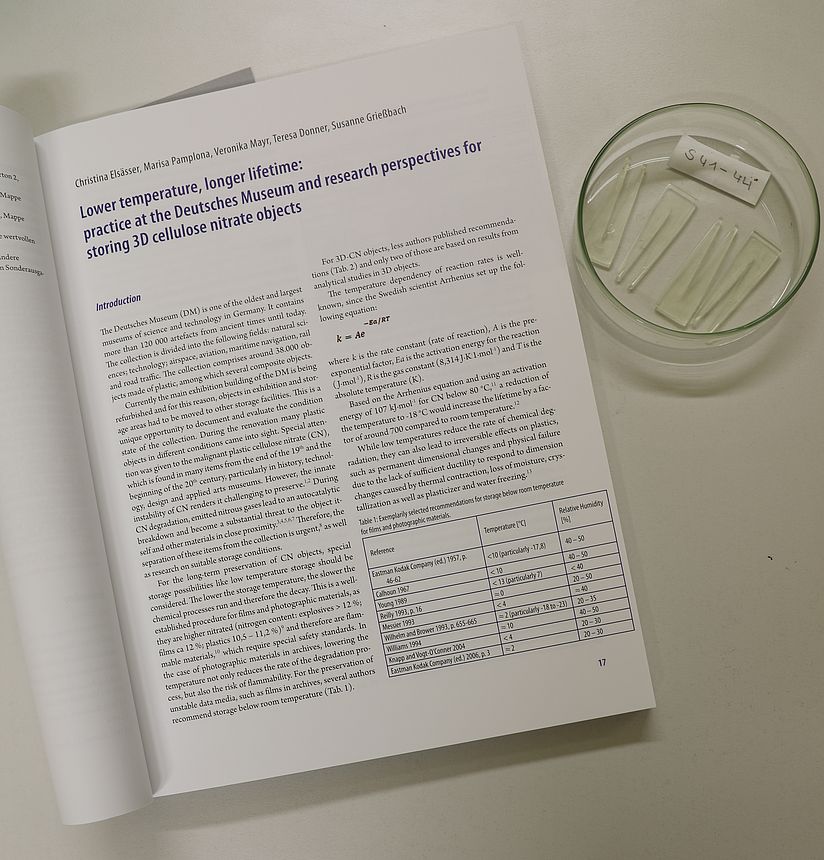
Photo: Deutsches Museum
Christina Elsässer, Marisa Pamplona, Veronika Mayr, Teresa Donner, Susanne Grießbach
Lower temperature, longer lifetime: practice at the Deutsches Museum and research perspectives for storing 3D cellulose nitrate objects
Abstract
Three-dimensional objects made of cellulose nitrate (CN) are very unstable; therefore, heritage professionals try to find suitable storage conditions to prolong their lifetime. This paper addresses the need to implement short-term storage solutions and define perspectives for future research. Based on the synergies between two departments at the Deutsches Museum (DM) and a collection survey, 91 CN objects were identified by Fourier transform infrared spectroscopy and shifted to a well-ventilated storage. However, for a long-term preservation of CN objects storage solutions below room temperature should be investigated. Therefore, from the 91 CN objects the most common shapes and material combinations, which are endangered by temperature changes, were determined. Results indicated that plates, tines and cylinders with metal pins are representative of the collection and adequate for future cool and cold storage research tests. Furthermore, an international poll dedicated to current storage practices and opinions on relevant variables for research investigations was performed. Even though professionals know the advantages of cold storage, this is rarely put into practice until now. They suggested to research the behaviour of complex geometries and composite objects at cold (-20 – 0 °C) and cool (0 – 14 °C) temperatures in the future.
citation:
Elsässer C., Pamplona P., Mayr V., Donner T., Grießbach S. (2021). Lower temperature, longer lifetime: practice at the Deutsches Museum and research perspectives for storing 3D cellulose nitrate objects. ZKK Vol. 34.
Presentations
- Elsässer, Christina; Pamplona, Marisa; Donner, Teresa; Mayr, Veronika; Micheluz, Anna; Grießbach, Susanne: How to deal with a self-destructive plastic in museum collections? Storing cellulose nitrate 3D objects at the Deutsches Museum. Virtual conference “Plastics in Peril: Focus on Conservation of Polymeric Materials in Cultural Heritage”, University of Cambridge Museums and Leibniz Research Museums, 17/11/2020. Digital presentation
- Elsässer, Christina; Pamplona, Marisa; Micheluz, Anna; Montag, Peter; Grosse, Christian U.: The ageing and preservation of 3D objects made of cellulose nitrate: possibilities and limits. Final conference “Of Glass Figures and other exhibition icons: Historical plastics research and preservation”, DHMD, Dresden, 20/09/2019.
- Micheluz, Anna; Elsässer, Christina; Pamplona, Marisa: Challenges in characterization of 3D-cellulose nitrate objects by EGA-MS and TD-Py/-GCMS. 9th MaSC Users Group Meeting, National Gallery of Canada, Ottawa (Canada), 06/06/2019.
- Micheluz, Anna; Elsässer, Christina; Montag, Peter; Pamplona, Marisa: Challenges in characterization of 3D-cellulose nitrate objects: Experimental design and preliminary results. Conference “The Plastics Heritage Congress 2019”, CIUHCT, Lisbon (Portugal), 31/05/2019.
- Elsässer, Christina; Micheluz, Anna; Pamplona, Marisa; Montag, Peter; Donner, Teresa; Grosse, Christian U.: Challenges and opportunities in assessing the effectiveness and harmfulness of storage conditions for three dimensional cellulose nitrate museum objects. Research Seminar “Yhip 2019”, FCT NOVA, Lisbon (Portugal), 28/05/2019.





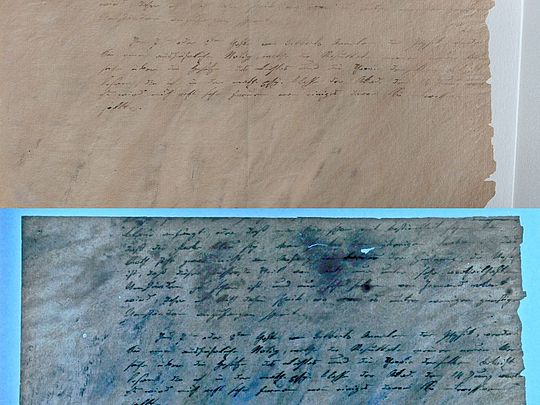
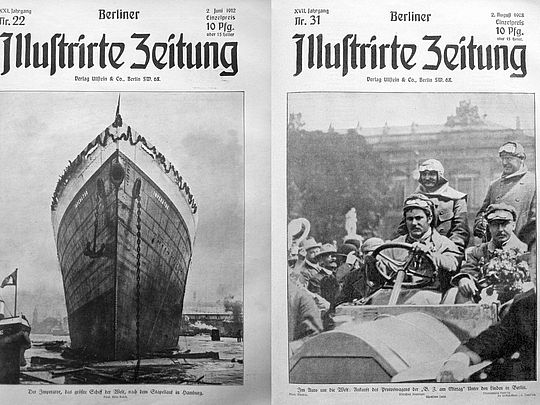
![[Translate to English:] [Translate to English:]](/assets/_processed_/f/a/csm_Forschung_Projekt_RCC2_4949d83dc2.jpg)